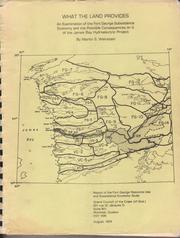
What the land provides
By Martin S. Weinstein
Subjects: Environmental and socio-economic aspects of Hydroelectric reservoirs and development, Canadian North, James Bay Hydroelectric Project, James Bay Hydroelectric Project impacts, Aboriginal land use and sustainable living, Northern Quebec, Hydroelectric power plants, Canada Aboriginal Rights, Economic conditions, Cree Indians, Aboriginal food economy
Description: Since the early 1970s many Canadian aboriginal communities have initiated major mapping research projects to document their use and occupancy of historical lands. The studies were designed for assessing impacts of natural resource “mega-projects” and for negotiating treaties with government in regions of Canada in which treaties had never been signed. “What the Land Provides” is a methodological pioneer within these studies. It was conducted by the James Bay Crees of Quebec in 1973 during their resistance to a massive government hydro-electric proposal, and it was completed during the negotiation of the James Bay and Northern Quebec Agreement -- the first modern Canadian aboriginal rights treaty. The objective of the study was to map and quantitatively document the Fort George (now-Chisasibi) Cree hunting and fishing food harvesting economy. The method developed for the Fort George Study combined land use and household food harvesting surveys. The study mapped the locations of an annual harvest of over 200,000 kilograms of food from about 40 species or groups of mammals, birds and fish by a community of 1500 people on an approximately 60,000 sq km territory. The information was then used to assess the impact on the food economy of flooding within the large hydroelectric reservoirs. In part, the study was a socio-economic impact assessment of the hydro proposal, limited to land and resource use. However, it also addressed questions of the meaning of the land and about the nature of the social adaptations which have allowed aboriginal peoples to live historically and continue to live on their lands on sustainable and self-reliant basis.
Comments
You must log in to leave comments.